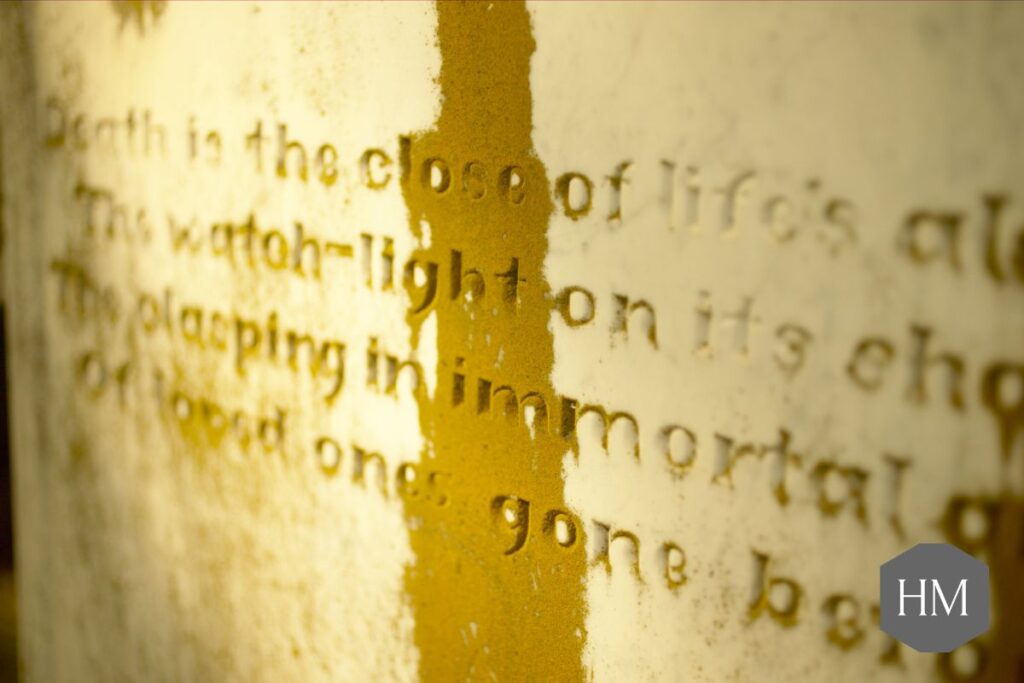You’ve likely encountered epitaphs before, even if you didn’t know what they were called. These brief inscriptions on gravestones or memorial plaques serve as a final tribute to those who’ve passed. But there’s more to epitaphs than meets the eye. They’re not just simple farewells; they’re windows into history, culture, and human nature.
From ancient civilizations to modern times, epitaphs have evolved in form and function, reflecting changing societal values and attitudes towards death. As you ponder your own mortality or consider how to honour a loved one, understanding the art and significance of epitaphs becomes increasingly relevant.
At a glance
- An epitaph is a brief tribute inscribed on a gravestone or memorial plaque to honour the deceased.
- It typically reflects the life, achievements, or personal qualities of the individual who has passed away.
- Originating from Greek, epitaphs have evolved from simple inscriptions to elaborate literary forms across cultures and time periods.
- Epitaphs serve as memorial inscriptions, historical records, and cultural artefacts, providing insights into societal attitudes toward death.
- Choosing an epitaph involves capturing the essence and legacy of the deceased, often considering their personality, values, and accomplishments.
What is an epitaph?

An epitaph is a brief tribute etched in stone, serving as a final farewell to the departed. You’ll often find these inscriptions on gravestones or memorial plaques, offering a lasting remembrance of the deceased. Epitaphs can take various forms, from simple statements to poetic verses, reflecting the individual’s life, achievements, or personal qualities.
The word “epitaph” comes from the Greek “epitaphios,” meaning “funeral oration.” This practice of commemorating the dead through inscriptions dates back to ancient civilizations, including the Egyptians, Greeks, and Romans. Over time, epitaphs have evolved in style and content, but their purpose remains the same: to honour and preserve the memory of those who’ve passed.
You’ll notice that epitaphs often include common phrases like “Here lies” or “Rest in peace.” However, many are uniquely crafted to capture the essence of the deceased.
These inscriptions serve as personal memorials and cultural artefacts, offering insights into societal attitudes toward death and remembrance. When choosing an epitaph, consider how you’d like your loved one to be remembered for generations to come.
Where does the word epitaph come from?
You’ll find that the full Greek phrase “epitaphios logos” means “funeral oration” or “speech in honour of the dead.” This connection to funeral speeches highlights the commemorative nature of epitaphs.
As you explore the history of epitaphs, you’ll discover that they’ve been used since ancient times, with the earliest surviving examples found on Egyptian sarcophagi.
Over time, the concept of epitaphs has spread to various languages and cultures, adapting to reflect different customs and beliefs surrounding death and remembrance.
The use of epitaphs has evolved from simple inscriptions in ancient times to more elaborate literary forms, particularly during the Elizabethan era.
Today, when you visit a cemetery, you’ll often find epitaphs serving as brief yet meaningful inscriptions on tombstones, preserving the memory of the deceased for generations to come.
The history of epitaphs

The history of epitaphs stretches back to ancient civilizations, with the earliest examples cropping up on Egyptian sarcophagi. These inscriptions served to honour the deceased and provide for them in the afterlife.
As you explore the evolution of epitaphs, you’ll notice distinct cultural influences shaping their style and content.
In ancient Greece, epitaphs often featured emotive expressions and elegiac verse, reflecting a deep appreciation for poetry. The Roman Empire, however, favoured straightforward, factual epitaphs inscribed in Latin, emphasising the individual’s name and achievements.
Here’s a quick overview of epitaph evolution:
- Ancient Egypt: Inscriptions on sarcophagi
- Ancient Greece: Poetic and emotive expressions
- Roman Empire: Factual, Latin inscriptions
- 16th century England: Literary and artistic epitaphs
What is the purpose of an epitaph?
As epitaphs have evolved throughout history, their fundamental purpose has remained constant. An epitaph serves as a memorial inscription that honours the deceased, reflecting their life, achievements, and personal qualities. When you visit a gravesite, you’ll often find these brief statements conveying sentiments of love, respect, and remembrance for the individual.
The purpose of an epitaph extends beyond simple commemoration. It’s a way to preserve historical records of the deceased’s life and the societal values of their time. As you read an epitaph, you’re reminded of mortality, prompting reflection on life and legacy. This contemplation can provide comfort to those grieving and inspire visitors to contemplate their own impact on the world.
Epitaphs also serve to reinforce the deceased’s character and beliefs, highlighting their lasting influence on family and community. By crafting a thoughtful epitaph, you’re creating a lasting tribute that encapsulates the essence of a person’s life and guarantees their memory endures.
It’s a final opportunity to share the deceased’s story and values with future generations.
How to choose an epitaph

Choosing an epitaph can be a deeply personal and meaningful process. When selecting an inscription for your loved one’s tombstone, consider their personality, values, and achievements. This final expression should capture their essence and legacy, serving as a lasting tribute to their life.
To choose an appropriate epitaph:
- Reflect on your loved one’s character and memorable qualities
- Consider their significant accomplishments or life philosophy
- Explore different formats, such as poetic verses or simple phrases
- Consult family and friends for meaningful anecdotes or sentiments
Research notable examples of epitaphs for inspiration, including humorous, poignant, or reflective inscriptions that resonate with your intended message.
Be mindful of cultural and religious traditions that may influence your choice of wording or themes, ensuring the epitaph aligns with your loved one’s beliefs.
For a comprehensive collection of epitaph ideas, you may find our article on Memorial Headstone Epitaphs: 200+ Beautiful Quotes & Sayings helpful in your selection process.
Frequently Asked Questions
What Is the Most Famous Epitaph?
You’ll find that Shakespeare’s epitaph is often considered one of the most famous. It’s a warning against disturbing his grave: “Good friend, for Jesus’ sake forbear, to dig the dust enclosed here. Blest be the man that spares these stones , and cursed be he that moves my bones.”
What Is the Purpose of an Epitaph?
You’ll find that an epitaph’s purpose is to honour and remember the deceased. It’s a way for you to encapsulate their life, values, and impact. You’re creating a lasting tribute that comforts loved ones and preserves personal history.
Is epitaph same as eulogy?
No, epitaph and eulogy are not the same. An epitaph is a short text inscribed on a headstone or grave marker in memory of the deceased person. A eulogy is a speech or written tribute praising someone who has died, typically delivered at their funeral or memorial service. Whilst both honour the deceased, an epitaph is brief and permanent, whereas a eulogy is longer and spoken.
Conclusion
Epitaphs are more than just words on a gravestone. They’re a meaningful way to honour your loved ones and preserve their memory. When choosing an epitaph, consider the person’s life, values, and impact. You don’t need to craft a masterpiece; sincerity is key. Remember, there’s no right or wrong choice.
Take your time, reflect on your memories, and select words that resonate with you and truly capture the essence of your loved one. For expert guidance and a compassionate approach to creating the perfect epitaph, reach out to Haven Memorials. Our team is dedicated to helping you craft a lasting tribute that beautifully honours your loved one’s memory.
